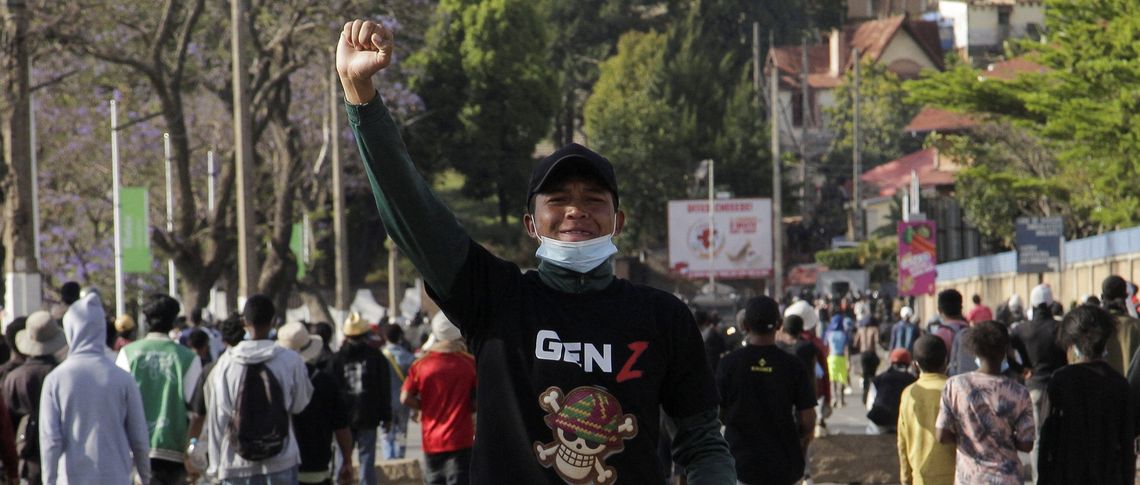Sunday is a day of rest in Madagascar. Churches are full to the rafters; families get together for lunch afterwards; and the streets are quiet and empty. The scent of purple-flowering Jacaranda trees wafts through the air, and street dogs bask in the sun. Even when times are turbulent, when parts of the population have been demonstrating peacefully amidst tear gas fired by the security forces, even when the president finds himself in an unknown location abroad, or a colonel has taken over the reins of government: on Sunday, everyone sits down together in prayer.
But even on Sunday, one can expect to see long queues of ‘bidon jaunes’, yellow plastic cannisters, lined up at public water points. This highlights an existential problem that has existed for years, namely Madagascar’s failure to provide even the most basic public services. There are regular shortages of electricity and water. Anyone with solar panels on the roof or their own water source in the garden can count themselves lucky. For everyone else, power outages lasting up to 13 hours a day or water pipes that run dry for days or even weeks on end are part of everyday life. Hygiene problems, difficulties in organising daily life and drinking water shortages characterise the lives of most people. But despite the growing frustration, for a long time, there were no major public protests. Fears of surveillance and repression ran too deep in a country whose regime, though democratic on paper, has been showing alarming authoritarian tendencies.
A remarkable achievement
The trigger for the most recent demonstrations in mid-September was the public protest in front of the Senate by two opposition city councillors in the Madagascan capital Antananarivo. After, in their capacity as the people’s elected representatives, they had denounced the water and electricity shortages, they were briefly arrested for disturbing public order. After their release the following day, they called for a demonstration. Students and young activists not only heeded this call, but themselves mobilised massively on social media. Emulating the Gen Z protest movements in Indonesia, Kenya and Nepal, they adopted as their logo the ‘One Piece’ pirate symbol decorated with a traditional Madagascan straw hat.
Rallies have been held despite the authorities’ ban. The security forces resorted to tear gas and rubber bullets against peaceful demonstrators. The first day of demonstrations was particularly intense. In the course of the day, the houses of two government MPs were attacked, followed in the evening by looting, apparently initiated by paid provocateurs and then taken up by opportunists. Gen Z demonstrators, who feared a deliberate attempt to discredit their movement, clearly distanced themselves from the rioting and helped the victims to clean up the next day. According to the UN, at least 22 people lost their lives and over 100 were injured in the course of the nationwide protests, strikes and looting, although the government has contested these figures. In a later TV address, then-President Andry Rajoelina blamed cyber attacks from abroad for the protest movements.
The fundamental hurdle of publicly taking a stand as a movement critical of (those in) power appears to have been overcome, at least for the time being.
It was remarkable that the following week, representatives of Generation Z were also able to mobilise members of the older Generation Y and thus large parts of established civil society. This generation still has vivid memories of the 2009 coup and has avoided street protests in recent years. After initially calling for the resignation of the government, young people then demanded the resignation of the president, the dissolution of the senate and the electoral commission, and the criminal prosecution of the politically powerful businessman Mamy Ravatomanga, a de facto kingmaker. President Rajoelina dismissed his government at the end of September, admitted to mistakes and promised rapid improvements. But the strikes and demonstrations continued, even after he entered into dialogue with a wide range of actors, including trade unions, NGOs and churches.
After a part of the military finally sided with the peaceful demonstrators and against the president, Rajoelina was exfiltrated abroad with the help of French President Emmanuel Macron. In order to pre-empt the impending impeachment proceedings by the majority of parliament, Rajoelina swiftly dissolved parliament by decree from afar — a decree that was declared invalid by the Constitutional Court shortly afterwards. The Court also ruled that Colonel Michael Randrianirina should assume the highest office of state for a transitional period of up to two years, due to the absence of the president. The demonstrators celebrated these developments euphorically at the symbolic Place du 13 mai.
Although Generation Z’s approach seems somewhat haphazard, and the youth movement was initially surprised by its own success in mobilising people, it has done the population a crucial service. It has shaken up its compatriots, who had long been cowed by fear of repression or had sunk into a quiescent ‘somehow it will all work out in the end’ mentality. In this atmosphere, topics such as President Rajoelina's possible third term in office or the influence of businessman Ravatomanga were discussed only behind closed doors and in code. The fundamental hurdle of publicly taking a stand as a movement critical of (those in) power thus appears to have been overcome, at least for the time being.
What’s next?
Although the military, particularly the colonel who is due to be sworn in as president on 17 October, appears to be taking the demands of Generation Z seriously, they must ensure that the movement they started is not hijacked by this new set of actors for their own purposes. And even though political figures widely perceived as corrupt are currently being dismissed and replaced, the following two points should not be forgotten:
First, a publicly recognised dialogue forum should be set up to process current experiences and reconcile the nation once again. This forum must also dare to tackle the structural roots of Madagascar’s injustices. Traditionally, churches enjoy a high level of popular trust and have often proved to be valuable mediators in transformation processes. They could moderate an inclusive process and thus ensure that the voices of all key social groups and groupings – not least Gen Z – are heard.
It is not enough to have some new faces — the basic structures need to change.
Second, the protestors must set their sights beyond individual actors, such as Ravatomanga. The amalgamation of his business empire with politics is itself an expression of structural imbalances and the all-pervasive lack of transparency. Without fundamental systemic reforms, the underlying abuses would remain even if it proves possible to remove individuals from their positions of power. The social contract needs to be renegotiated to expose corruption, political entanglements and economic unfairness, while identifying alternatives serving the common good. Corruption is such a fixed feature of everyday life and people’s very mentality that it needs to be tackled by society as a whole. There needs to be a common consensus on where corruption begins at the personal level and what kinds of damage it causes. Transparency, emphasis on the common good and a fair distribution of resources are other key elements of a different economic order. This long-term vision should be developed in parallel with the new constitution and discussed by society.
But sustainable improvements can be achieved only by combining public mobilisation, institutional mediation and systemic reform. It is not enough to have some new faces — the basic structures need to change. Within the EU, Germany could put more emphasis on the rule of law and human rights, and support long-term inclusive dialogue processes in cooperation with regional partners. Except on Sundays, Madagascar’s day of rest.






